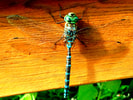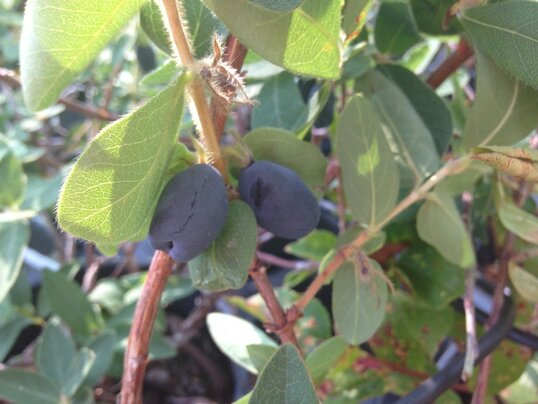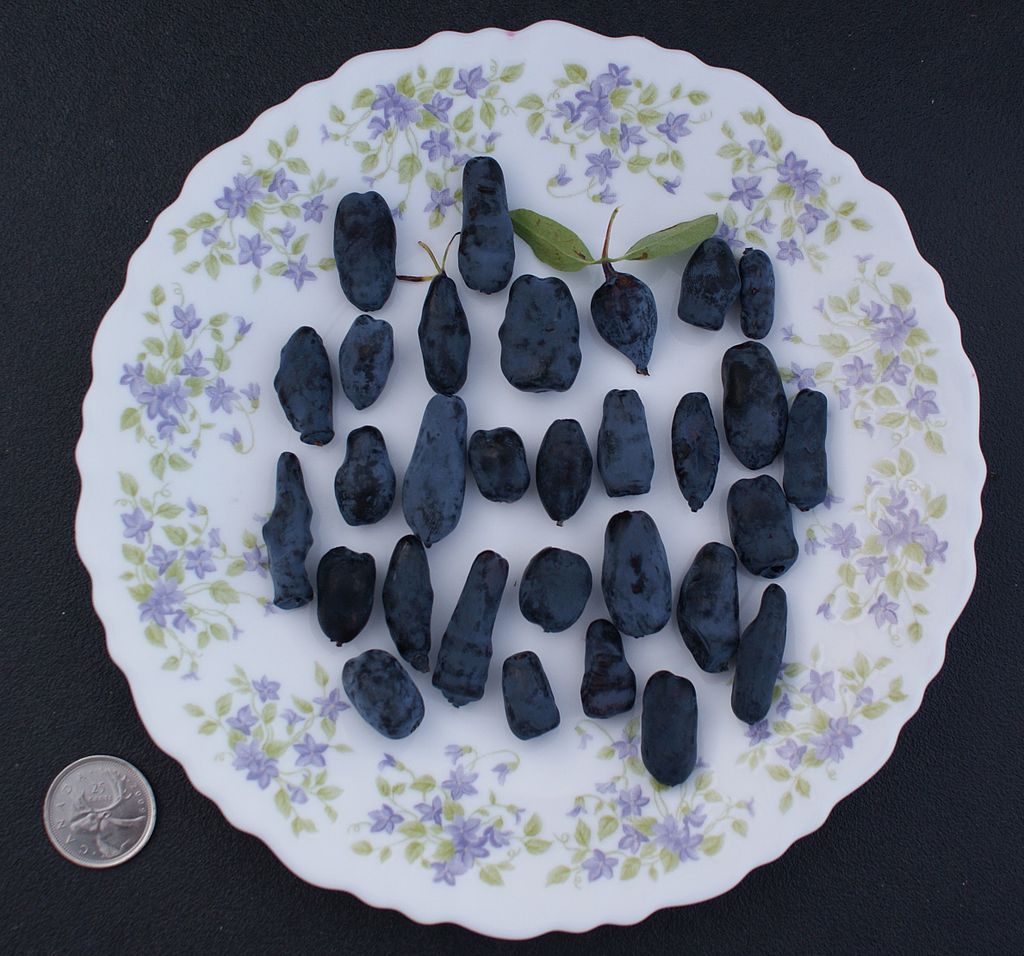HASKAP |
A Little History
The haskap species lonicera caerulea is native to the northern boreal forests of Asia, Europe and North America, usually found growing in high mountains or low lying wet areas. Historical use of haskap dates back centuries to the people of Hokkaido Island, Japan.
In the 1950’s, Siberian horticulturists collected wild samples and began breeding haskap. Haskap remained relatively unknown in North America until the late 1990’s when tasty cultivars began getting attention. In 1998, the University of Saskatchewan launched its own haskap breeding program. To date, U of S has produced some of the best varieties in the world.
The haskap species lonicera caerulea is native to the northern boreal forests of Asia, Europe and North America, usually found growing in high mountains or low lying wet areas. Historical use of haskap dates back centuries to the people of Hokkaido Island, Japan.
In the 1950’s, Siberian horticulturists collected wild samples and began breeding haskap. Haskap remained relatively unknown in North America until the late 1990’s when tasty cultivars began getting attention. In 1998, the University of Saskatchewan launched its own haskap breeding program. To date, U of S has produced some of the best varieties in the world.
Before You Plant – Choosing and Preparing the Planting Site
Select a planting site that receives 6+ hours of daily sun.
Decide how many plants you want. If you want to grow them as a hedge, space plants 3-4’ apart. If you want freestanding shrubs, space them 4-5’ apart.
Haskap are far more adaptable to wet soils and a broad pH range than most other fruits, though their preference is well-drained, somewhat acidic soil. Soil fertility is important so definitely add 2-6 inches of compost or manure to your garden soil. Adding several inches of peat moss is recommended too.
Ask your local garden centre if you have any specific concerns regarding your garden soil.
Select a planting site that receives 6+ hours of daily sun.
Decide how many plants you want. If you want to grow them as a hedge, space plants 3-4’ apart. If you want freestanding shrubs, space them 4-5’ apart.
Haskap are far more adaptable to wet soils and a broad pH range than most other fruits, though their preference is well-drained, somewhat acidic soil. Soil fertility is important so definitely add 2-6 inches of compost or manure to your garden soil. Adding several inches of peat moss is recommended too.
Ask your local garden centre if you have any specific concerns regarding your garden soil.
When to Plant
Haskap are usually available as early as mid-April. For the first few weeks, either
1. Keep them in a greenhouse, or
2. "Harden them off" (put them outside during the day but bring them inside at night)
By early May, it is normally safe to leave them outside.
Haskap are often available later and can be planted at any time in the growing season.
Haskap are usually available as early as mid-April. For the first few weeks, either
1. Keep them in a greenhouse, or
2. "Harden them off" (put them outside during the day but bring them inside at night)
By early May, it is normally safe to leave them outside.
Haskap are often available later and can be planted at any time in the growing season.
Buying Haskap
Ensure that you’re getting not only two different varieties, but two varieties which are compatible for pollination. Otherwise, no fruit for you! One variety is sometimes considered more desirable (i.e. – has better flavour, size) while the companion/pollinizer variety is primarily meant to help the desirable variety set fruit. The companion variety will still produce fruit.
If you want several haskap bushes, plant 1 pollinizer variety to every 6 of the desired variety plants.
To simplify things, growers often sell a single pot with two compatible varieties in it. If you’re buying individually potted varieties, check the plant tag for the recommended pollination pairing.
Haskap Varieties
Haskap flavour can vary from sweet to bitter to….awful. Fortunately, breeders have worked hard to improve flavour over the last few decades. When picking a variety, the main factors to consider are berry flavour, firmness and size. Many of the varieties available in Canada are Siberian/Canadian introductions released by the University of Saskatchewan.
Ensure that you’re getting not only two different varieties, but two varieties which are compatible for pollination. Otherwise, no fruit for you! One variety is sometimes considered more desirable (i.e. – has better flavour, size) while the companion/pollinizer variety is primarily meant to help the desirable variety set fruit. The companion variety will still produce fruit.
If you want several haskap bushes, plant 1 pollinizer variety to every 6 of the desired variety plants.
To simplify things, growers often sell a single pot with two compatible varieties in it. If you’re buying individually potted varieties, check the plant tag for the recommended pollination pairing.
Haskap Varieties
Haskap flavour can vary from sweet to bitter to….awful. Fortunately, breeders have worked hard to improve flavour over the last few decades. When picking a variety, the main factors to consider are berry flavour, firmness and size. Many of the varieties available in Canada are Siberian/Canadian introductions released by the University of Saskatchewan.
Also see the Proven Performer Varieties listed at the top of the page, in the Growing Haskap Overview section.
Varieties to Consider
- Tundra: Exceptionally firm and large berries with a melt-in-your-mouth texture and a high flavour ranking. Grows 4-5’ tall. Excellent for fresh eating, jams/jellies and wine. Pollinate with Honeybee or other recommended variety
- Borealis: Sweet and tangy but softer than Tundra. Often considered the best tasting variety. Grows 4’ tall. Pair with Polar Jewel, Aurora or other recommended variety
- Aurora: Slightly sweeter, larger, more productive and easier to pick than Borealis. Grows 5’ tall. Pair with Borealis, Tundra, or Indigo
- Polar Jewel: Sweet, deep blue berries. Eat fresh or use in baked goods, jams, and jellies. Pair with Tundra or Borealis
- Honeybee: Tall plant produces large, tart blue fruit. Use for making wine, juice, and jellies. Pair with Borealis or Tundra
Planting Time
So you've prepared the planting site and you've got your haskap bushes. Now space your haskap appropriately (refer back to the Before You Plant section if needed).
Water both the plant and the planting hole deeply. Add a handful of bone meal or other similar fertilizer at planting time. Haskap can be planted slightly recessed (1-2” below ground level). Once the bushes are in the ground add 2-4" of bark mulch or rotted sawdust. This will help keep the roots cool and moist. Water the plants once more.
Refer to our Guide to Planting Shrubs for further transplanting instructions.
So you've prepared the planting site and you've got your haskap bushes. Now space your haskap appropriately (refer back to the Before You Plant section if needed).
Water both the plant and the planting hole deeply. Add a handful of bone meal or other similar fertilizer at planting time. Haskap can be planted slightly recessed (1-2” below ground level). Once the bushes are in the ground add 2-4" of bark mulch or rotted sawdust. This will help keep the roots cool and moist. Water the plants once more.
Refer to our Guide to Planting Shrubs for further transplanting instructions.
Post-Planting Care
Since haskap is shallow-rooted, it is critical that the soil never dries out. Water the haskap deeply and infrequently (about once per week), especially during the first few years of growth.
In subsequent seasons, you may need to add more organic matter to maintain the soil's richness.
Haskap does not sucker and needs minimal yearly pruning. In early spring, thin out some of the old branches to maintain air circulation and vigorous growth.
Since haskap is shallow-rooted, it is critical that the soil never dries out. Water the haskap deeply and infrequently (about once per week), especially during the first few years of growth.
In subsequent seasons, you may need to add more organic matter to maintain the soil's richness.
Haskap does not sucker and needs minimal yearly pruning. In early spring, thin out some of the old branches to maintain air circulation and vigorous growth.
Harvesting and Eating
Allow haskap to fully ripen before harvesting – under ripe berries are not pleasant. Ripe berries will have a purple interior.
Ripe berries can even remain edible if they are left on the bushes for several weeks.
Haskap is commonly used to make:
Allow haskap to fully ripen before harvesting – under ripe berries are not pleasant. Ripe berries will have a purple interior.
Ripe berries can even remain edible if they are left on the bushes for several weeks.
Haskap is commonly used to make:
- Wines
- Juices
- Ice creams
- Smoothies
- Sauces and jams
- Baking sweets
Summary
Haskap is:
I’d say that’s a compelling case for growing haskap.
For further reading, check out Haskap Canada page or the University of Saskatchewan’s haskap page.
Haskap is:
- Incredibly hardy, rarely affected by cool springs or harsh winters
- Compact, requiring very little pruning
- Thornless
- Rarely affected by pests or diseases
- Early ripening (up to 2 weeks before strawberries)
- Heavily productive
- A recognized superfood – loaded with anti-oxidants, fiber and Vitamin C
- One of the few northern fruits that make excellent wine
I’d say that’s a compelling case for growing haskap.
For further reading, check out Haskap Canada page or the University of Saskatchewan’s haskap page.
6 Comments


